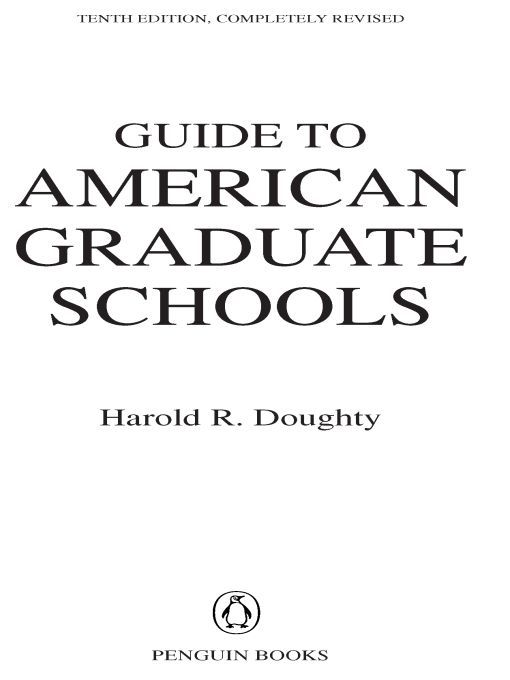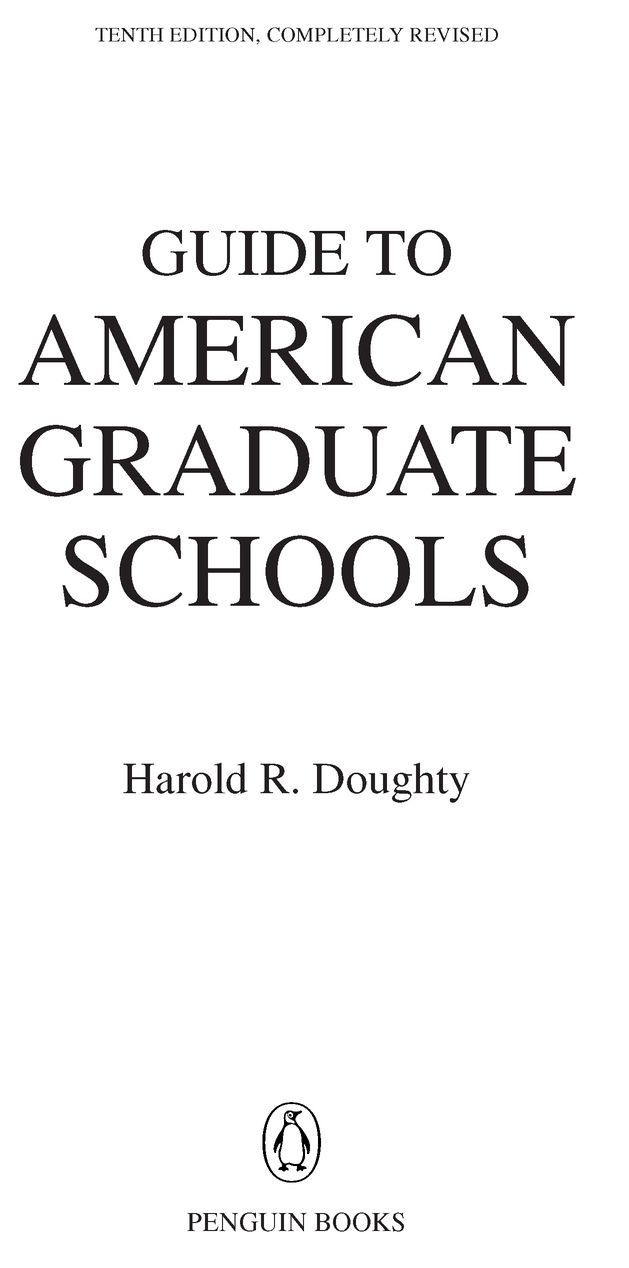Table of Contents
PENGUIN BOOKS GUIDE TO AMERICAN GRADUATE SCHOOLS
Harold R. Doughty is currently a Management and Educational Consultant. He was formerly a Human Resource Staffing Specialist and Recruiter for J.P. Morgan Chase & Company; Executive Vice President and Chief Operating Officer at American Commonwealth University; Vice President for Admissions, Financial Aid, and Enrollment Services at United States International University; Director of Admissions and Summer Sessions at New York University; and Director of Admissions and Freshmen Development at Adelphi University. He is also the author of The Penguin Guide to American Business Schools, The Penguin Guide to American Law Schools, and The Penguin Guide to American Medical and Dental Schools.
PREFACE TO THE TENTH EDITION
Crisis is a word grown impotent from overuse.
That sentence has opened every edition of this Guide since it was first published in 1967. Many of the traumata that inspired the remark are now so dated as to seem almost quaint. Some remain, festering. And still others, thought to be in remission, have returned to haunt us. The original observation continues to be valid, then, both for the American educational system and the larger society that supports it and receives its benefits.
Yet, despite a lingering propensity to react to challenges, rather than to anticipate them, our colleges and universities have managed to transform themselves in meaningful ways. This is specially true of the postbaccalaureate. From 1995 to 2006 the number of women graduating with a either a masters or doctoral degree has increased 150 percent and minority group registrations have doubled. In 2007, the number of doctorates awarded reached an all-time high of 55,300 with women earning almost 50 percent of those conferred. In addition, it is projected that by 2016 women will represent 56 percent of all doctorates awarded and that minority enrollment will level.
Problems persist, of course. Task forces of educators doggedly debate overproduction of doctorates, although the much-bemoaned Ph.D. glut is still confined primarily to the humanities and social sciences, and demand is still high for the products of most other disciplines. Complicating the anxieties of those same graduate faculties is the slowdown in the rate of increase of students pursuing advanced study. There is no decline in graduate enrollments, it must be understood. But after doubling every ten years since the turn of the century and tripling in the 1960s, graduate enrollments increased only from 1,031,000 in 1970 to 1,309,000 in 1979, to 1,742,000 in 1996 and is projected, over the next several years, to increase only slightly from the 2006 level of 2,250,000. The rush to advanced education has cooled, it is true, but it long threatened to boil over, so the results are not entirely negative. Unrestricted growth has been curtailed, costs are being contained, and some marginal academic operations are being eliminated or absorbed by those in which demand remains high. Under such circumstanceswhich should prevail throughout this decadethe quality of facilities and instruction should improve as universities learn to live within their means and focus on those areas in which they can best serve their client students.
Despite these contractions, applications for admission in most fields have remained constant. As education beyond high school has become a commonplace expectation, the demand for further training intensifies, if only to give a competitive edge in an ever-more-credentialed and specialized marketplace now being governed by consumer-oriented licensure requirements and regulations. That this is true is exemplified by the marked upswing in candidates for the masters degree, especially in business administration, computer application, and other narrowly defined and specialized programs. In spite of this, the current graduate student is being torn between the perceived need for graduate study and the immediate desire for career or job and instant financial gratification. The burdensome overabundance of applications of the past, which swamped understaffed administrative offices, has been greatly reduced. Higher application fees, earlier and earlier deadlines, and more stringent entrance standards, long a hallmark of the oversubscribed, have given way to the need for many graduate schools to market and offer programs via the Internet, use direct mail solicitations, and actively recruit students in order to maintain an adequate applicant pool. Full-time study has given way to part-time. Indeed, full-time faculty has in many cases had to give way to more specialized part-time or adjunct associates. It is fair to say that only a few prestigious institutions can hold to and enforce the high academic requirements of just a few years ago.
Those full-time applicants who gain entrance to the fabled colleges of their choice are now confronted by financial difficulties substantially greater than those experienced in their undergraduate years. The belief that ample financial aid funds await the use of every graduate student is quickly dispelled. Inflation, tight money, and parents who often are unable or just unwilling to subsidize further education force many students to assume staggering financial burdens just when he or she is least able to afford them. This may be the first confrontation with the practical reality that graduate students must have alternative financial means in order to afford the graduate education they desire. This scenario further reinforces the belief that to find employment now will give the needed direction to pursue graduate study on ones own, the direction that is so often missing in undergraduate study.
Although college guidance is fully developed at the high-school level, no equivalent counseling structure exists for the potential graduate student. Such advisement as is available is provided by a small number of placement officers and faculty members concerned that able students realize their full potential. Unfortunately, no single individual can keep abreast of current offerings at even the major institutions. Indeed, it is difficult to keep track of developments within a single large university. Despite these obstacles, it remains true that most students who hold bachelors degrees can gain admission to some graduate school in any section of the country.
This volume is designed to provide the kind of basic information students need to reach sound decisions in the selection of appropriate institutions at which to continue their education. It describes more than thirteen hundred institutions throughout the United States providing graduate and professional study. All have been reviewed once again for this tenth edition of the Guide to American Graduate Schools, and still more complete information has been sought from their Web sites.
Listed are programs in all areas of the liberal arts and sciences, education, medicine, dentistry, veterinary medicine, pharmacy, nursing, law, social work, agriculture, theology, the applied arts, engineering, and business. Admission and degree requirements, standards, enrollment and faculty figures, tuition charges, financial aid opportunities, and research and housing facilities are given whenever possible. While this book has been prepared with the student in mind, it is hoped that counselors, faculty, and administrative officers will find it of value, as well.


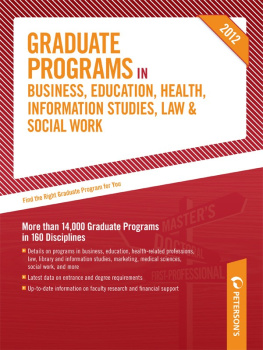
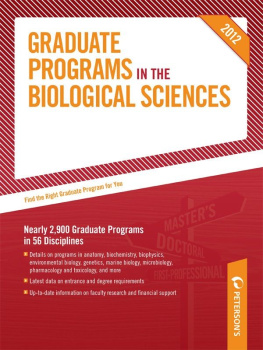
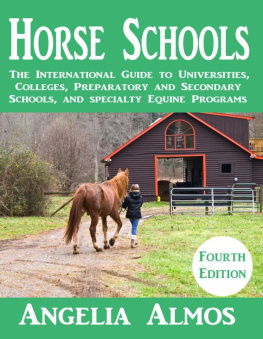
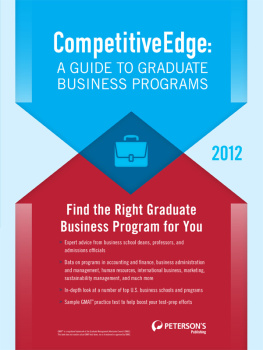
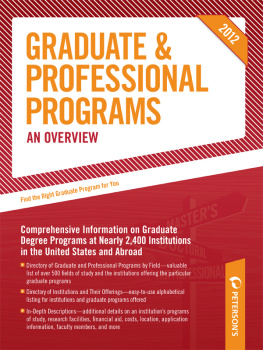
![Reding - Grads Guide to Graduate Admissions Essays] : Examples from Real Students Who Got into Top Schools](/uploads/posts/book/101661/thumbs/reding-grad-s-guide-to-graduate-admissions.jpg)
